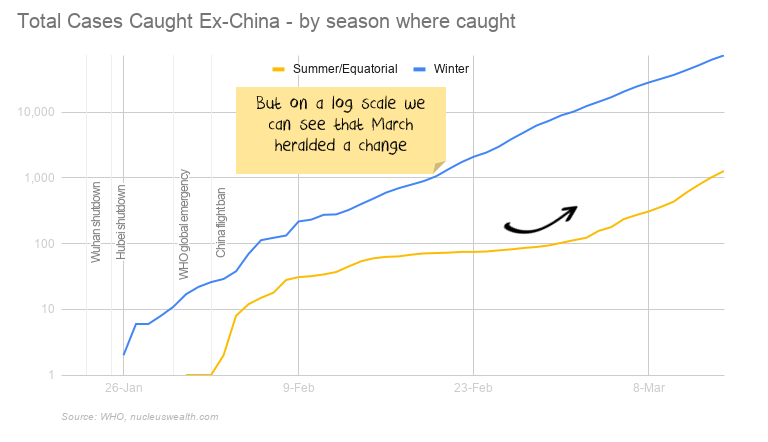One factor I have been watching closely is the spread of the coronavirus through summer or tropical countries. For most of February, it appeared travellers brought COVID-19 to summer or tropical countries, but the spread within those countries was limited. That looks to be changing.
The raw chart comparing the two still suggests a stark difference:
But other charts are showing early negative signs:
Quick Data background
We split cases into:
- Winter countries: Northern Hemisphere Countries currently in winter
- Summer/Equatorial countries: Southern Hemisphere countries now in summer or Countries near the equator where temperatures are relatively high all year
The data in these charts are based on where the case was caught rather than diagnosed. For example, a case caught in Iran but diagnosed in Thailand would be assigned to winter.
All of these charts are available (updated daily) for all countries here.
Taking a turn for the worse
Signs are growing that tropical/summer countries are falling to the virus.
While the numbers are still low, they are snowballing.
And when you look through the countries, lots are showing the typical progression before cases really take off:
Scientific Background
There are suggestions that UV-B radiation and vitamin D played a role in reducing deaths in the Spanish Flu pandemic. Other studies suggest humidity greatly reduces the aerosol transmission of viruses, but some suggest humidity increases surface transmission. It is unknown how these affect COVID-19 – many experts warn against being too optimistic.
Economic Impact
There are two elements to the coronavirus:
- Humanitarian. The bigger the shutdowns, the greater the preventative measures, the fewer people will die.
- Economic. The bigger the shutdowns, the greater the preventative measures, the more significant the economic impact will be.
In the early stages, for many countries, the focus was mistakenly on minimising the economic impact. That is no longer the case. It is about preventing the spread of the disease. Or, for politicians, at least been seen to be trying. The economy is no longer the issue.
At the moment our base case is coronavirus outbreaks will be worse in colder countries. Last month, we were hoping tropical or summer countries would mostly avoid the virus, but that assumption is looking increasingly shaky.
I’m still assuming summer/tropical countries will be less affected medically. However, it is looking increasingly likely that those countries will need to enforce strict quarantines anyway. And so the economic impact may not be much better than winter countries.
Investment Outlook
The economic impact may even be worse on Southern Hemisphere countries. The natural progression of the virus combined with summer may mean the threat eases in the Northern Hemisphere over the next 2-3 months. Potentially just as the virus is receding in the Northern Hemisphere the Southern Hemisphere may get an intensification with winter that requires extended quarantines.
South-East Asia typically has increased influenza from August, so it may see the same effect.
So, caution is still the by-word.
Our impression is countries affected by SARS are dealing with COVID-19 better than those that weren’t. We expect these countries will recover more quickly.










